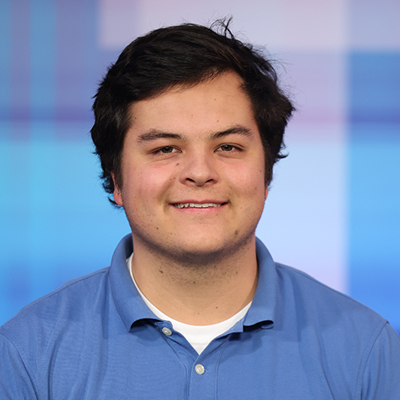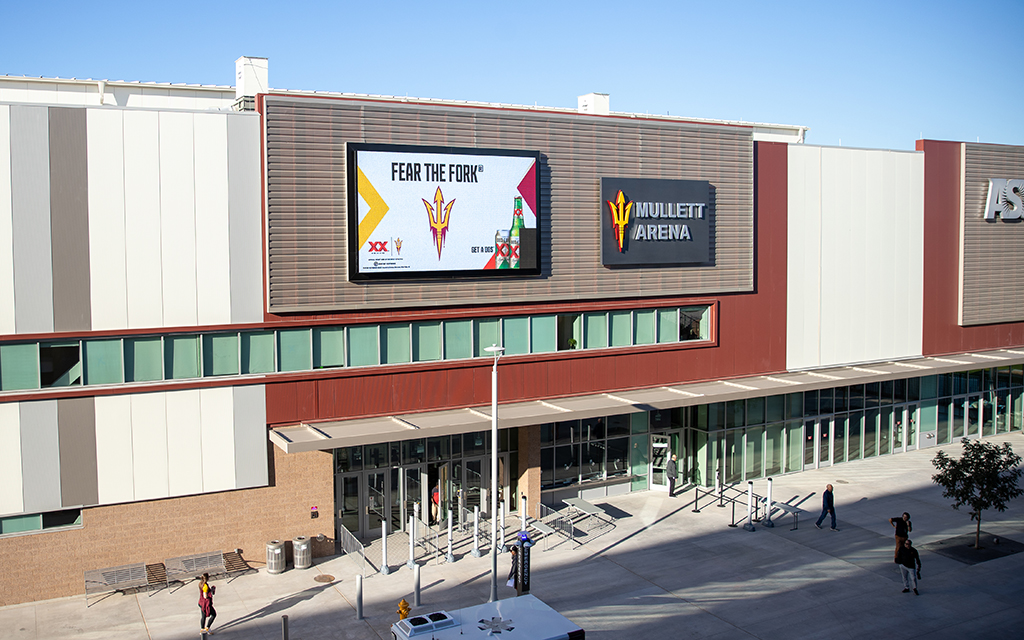TEMPE – The locker room door of the ASU men’s ice hockey team opens to a painting of the not-so-distant past – Oceanside Ice Arena, the home of Sun Devils hockey from 1979 to 2022. Once the team passes the mural ahead of Friday’s season opener, it will skate onto the ice at brand new Mullett Arena in front of 5,000 fans and into the present of Sun Devils hockey.
For coach Greg Powers and the program, the moment will be surreal.
“[A new arena] was always a pipe dream for me, and really all the guys I played with,” Powers said. “Dating back to 1979, [the players] would always joke about [moving out of Oceanside], and it’s happening.”
Mullett Arena is as impressive as Oceanside is small, and players will have no problem lifting the puck in the air to clear the defensive zone. Step inside the brand-new building, and it feels as if it’s meant for big-time events.
While not close to the size of most NHL arenas, Mullett Arena feels equally polished – with the added bonus of each seat being close enough to the action so fans can recognize the speed of the game and hear the loud pop of the puck gliding from stick to stick.

The wait is over for Arizona hockey fans. Mullett Arena will welcome the ASU men’s ice hockey team in Friday’s home opener against Colgate. (Photo by Susan Wong/Cronkite News)
The arena has a main seating bowl that contains the majority of the 5,000 capacity, complete with 658 premium club seats, 10 concourse center-ice loge boxes, five rinkside loge boxes and the student section behind one of the goals for the 942 Crew.
The second level consists of the broadcast booths and press box, in addition to 22 suites that line the sides of the rink, bridged on one end by a viewing deck. Above center ice hangs a large, four-sided jumbotron.
“It’s so surreal,” graduate student forward Demetrios Koumontzis said. “It’s going to send a message that we’re a real team now. Even though we were before, I don’t think we got a lot of respect.”
The new facilities won’t only help gain respect and other intangibles. It will open a new set of doors for a Division I program that hopes to rise to the top of college hockey.
“We’re going to have access to resources and quite frankly to players we’ve never had access to,” Powers said.
While Powers didn’t directly say it, it’s easy to imagine how playing at Oceanside limited the Sun Devils in recruiting some of the sport’s best young players. Would a premiere prospect want to play in a community rink with a 747-seat capacity and a low ceiling that could impact the game? In most cases, probably not.
Look no further than the all-important transfer portal to find evidence of the facility’s impact.
“[The new arena] was definitely a perk,” said ASU goaltender TJ Semptimphelter, an offseason transfer from Northeastern. “Seeing the renderings of what the rink was supposed to look like was nothing but thrilling.”
Arizona State men’s hockey isn’t the only team benefitting from the new facility. The ASU women’s club team will also use the facility, and the Arizona Coyotes will play in Mullet Arena until the team’s permanent home is built. The complex will also feature Mountain America Community Iceplex, which will host skating lessons, club and adult hockey games, and figure skating.The hope is that the entire facility will accelerate hockey’s growth in the Valley.
Sophomore forward Josh Doan, a Coyotes draft pick and the son of Coyotes franchise scoring leader and team executive Shane Doan, grew up in Scottsdale and has witnessed the sport gain popularity first-hand.
“ASU runs camps in the summer and getting to watch those kids play now in camps that weren’t around when we were kids just goes to show how far the game has come (in Arizona),” Josh said.
After Friday’s ribbon-cutting ceremony and pregame festivities, ASU has an actual game to play against Colgate once the puck drops. The Sun Devils are confident that preparation and focus won’t be an issue despite their new home drawing much of the attention.
“Everyone is preparing the same way,” Koumontzis said. “Now we just have a way better spot to do it in.”
While Mullett is undisputedly “better” than Oceanside, as Koumontzis said, the mood is not disdain for the four-plus decades spent at the older rink. Instead, there’s a sense of pride in how the program was able to grow to this point.
“God bless Oceanside,” Powers said. “We miss it, but when you get into a place this nice that has the resources we now have access to, it proves how well we did with what we had to work with. We’re really proud of that.”



